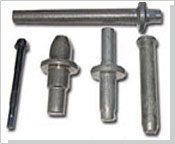 This process is a variation of the impression die forging. Cold forging process can be of many types, like cold heading, bending, cold drawing, to get a diverse range of products. The Essential components of the cold forging process are the die material and shape, the workpiece material, lubricant and the temperature.
This process is a variation of the impression die forging. Cold forging process can be of many types, like cold heading, bending, cold drawing, to get a diverse range of products. The Essential components of the cold forging process are the die material and shape, the workpiece material, lubricant and the temperature.
Cold forging is generally done at room temperature or at a temperature where there is no changes in the micro structure of the metal. It's a compressive process where metal workpieces are plastically shaped by contoured dies by squeezing it between the dies.
The process starts with a chemically lubricated bar slug forced inside a closed die under very high pressures. The metal then flows and takes the desired shape. The Material used can be lower end alloys and carbon steels to 300 and 400 series stainless steel, selected aluminum alloys, bronze and brass. There is a constant quest to optimize the production processes and decrease the costs. In this direction techniques like numerical analysis and simulations are now increasingly used.
Cold Forging Methods: Cold forging can be done by the following three processes.
Forward Extrusion:In this process the metal flows in the direction of the ram force. It reduces the slug diameter by increasing its length. Typically used to produce stepped cylinders and shafts.
Backward Extrusion:Here the metal flow is opposite to the ram force. It generates hollow parts. Typical Application for mass production.
Upsetting or Heading:In this process the metal flows perpendicularly to the ram force thereby increasing the diameter and reducing the length. Typically employed for making fasteners.
Application of the Cold Forging ProcessParts to be forged by this process are most cost-effective when the weight is 10 lbs or less. It gets precedence when integral design features are to be incorporated like built-in flanges and bosses. Cold forgings are very popular with the automobile industry for manufacturing steering and suspension parts, anti lock-braking systems, axles, bits, clutch hubs, gears, pinions, pins, step and intermediate shafts and sleeves.
